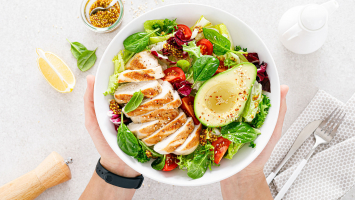Top 10 Simple Tips to Eliminate Gluten from Your Diet
Although the majority of people can consume gluten without any problems, those who have celiac disease or non-celiac gluten sensitivity may have negative ... read more...effects. After eating gluten, those who have gluten disorders may have symptoms such as rashes, headaches, fatigue, and stomach pain. Here are some Simple Tips to Eliminate Gluten from Your Diet!
-
Popular grains that contain gluten include wheat, barley, and rye. There are many gluten-free grain options available, though. Grain varieties free of gluten include:
- Quinoa
- Brown rice
- Millet
- Amaranth
- Buckwheat
- Oats
- ...
Contrary to its name, buckwheat is a grain-like seed that is naturally gluten-free and unrelated to wheat. You may use buckwheat in recipes for gluten-free baked goods or as a cereal. Or quinoa is one of the most popular gluten-free grains nowadays. It is very versatile and a great source of fiber and plant-based protein. Oat is another great option naturally gluten-free. However, oat processing can expose them to gluten, so choose oats with a certified gluten-free label if you have celiac disease or gluten sensitivity.

Choose gluten-free grains 
Choose gluten-free grains -
Gluten-free claims on food packaging are governed by the Food and Drug Administration (FDA). Less than 20 parts per million (ppm) of gluten must be present in a product for it to be labeled as gluten-free according to the FDA standard. Similar rules apply to food products marked as gluten-free in the European Union (EU).
The establishment of gluten-free certificates for food manufacturers is another development by many third-party organizations. These are additional certifications, and the food item must still comply with legal requirements. The Certified Gluten-Free label, for instance, was developed by the Gluten Intolerance Group and requires for products to have a gluten content of 10 ppm or below. For this organization, annual inspections and ongoing testing are necessary to ensure compliance.

Look for a gluten-free certification label 
Look for a gluten-free certification label -
Natural gluten-free properties are present in all fresh produce. You may obtain nutrients and get rid of gluten by increasing your intake of fresh fruit.
Here are some ideas for increasing your intake of fresh fruit and vegetables:
- Ask for a lettuce wrap rather than bread.
- Substitute spiralized vegetable noodles for regular pasta.
- Choose a salad rather than a sandwich.
- For a side dish that is free of gluten, try roasted potatoes or butternut squash.
- Choose a side of roasted veggies or fresh fruit.
- A slice of fruit can be eaten as a snack or added to your breakfast.
- Substitute pieces of sweet potato for the bread.
- ...
Gluten may be included in some processed fruits and vegetables as a thickening agent or food additive, such as frozen or canned products. When selecting fruits and vegetables that are canned, frozen, or dried, it is best to check the label for gluten or wheat.

Eat more fresh produce 
Eat more fresh produce -
Check the items in your pantry and remove any that could contain gluten. Reading the ingredient list is the most effective way to determine whether a product contains gluten. Items made of grains like wheat, barley, and rye should be thrown away or donated.
Look out for lesser-known gluten-containing ingredients including seitan, brewer's yeast, and malt vinegar. If other family members don't have the same dietary requirements as you, eliminating gluten from your diet may be challenging. In this situation, think about setting up a part of your pantry for gluten-free products. Additionally, this lessens the chance of cross-contamination and unintentional gluten consumption. Using a separate toaster and washing cutting boards and utensils before to food preparation are further ways to prevent unintentional exposure.

Clean out your pantry 
Clean out your pantry -
Some beverages, particularly those with alcohol, may contain gluten. Because it is made by fermenting gluten-containing grains like wheat or barley, beer is a common source of gluten. However, there are some beers that are available that are gluten-free and made from sorghum or rice.
Choose distilled liquors like vodka or gin if you're on a gluten-free diet and want to consume alcohol. Wine often doesn't contain gluten either. However, malt barley, a grain that contains gluten, may be included in wine coolers. The majority of non-alcoholic beverages, including coffee, tea, and sparkling water, are gluten-free. However, it's best to read the label because some beverages, such as pre-made smoothies, coffee drinks, or milkshakes, may contain gluten. Just drink alcohols made without grains or those that make it clear they are gluten-free if you are going gluten-free.

Avoid gluten-containing beverages 
Avoid gluten-containing beverages -
Condiments and sauces often contain hidden sources of gluten. Gluten can be added to condiments by food manufacturers to act as a stabilizer, thickener, or emulsifier. It's crucial to keep in mind that a condiment may include gluten from rye or barley even if it doesn't contain wheat. For example, because malt is made from barley, malt vinegar contains gluten. Before using any condiments, it is essential to check for any foods that may have gluten in the ingredients. You may buy or make your own gluten-free condiments using gluten-free products.
The following condiments may contain gluten:
- Soy sauce
- Salad dressing
- Malt vinegar
- Marinades
- Barbecue sauce
- Pasta sauce
- Worcestershire sauce
- Teriyaki sauce
- ...

Avoid gluten-containing condiments 
Avoid gluten-containing condiments -
Diets free of gluten are more likely to be deficient in fiber, calcium, and zinc. Nuts and seeds are excellent sources of these nutrients and are naturally gluten-free. Good amounts of protein, fiber, healthy fats, vitamins, and minerals may be found in nuts and seeds. As their fats are not completely absorbed, nuts and seeds control body weight and food intake. You may mix nuts and seeds into gluten-free oats, grind nuts into flour to replace wheat flour, sprinkle seeds on salads, or make nut butter from nuts to go well with apple slices or celery sticks.
Include the following nuts and seeds in your diet:- Almonds
- Cashews
- Pecans
- Walnuts
- Pistachios
- Macadamia nuts
- Pumpkin seeds
- Flax seeds
- Chia seeds
- Sunflower seeds
- ...

Eat more nuts and seeds 
Eat more nuts and seeds -
Wheat comes in a wide variety, making it challenging to read food labels. When checking a label for possible gluten sources, look for these types of wheat: durum, einkorn, khorasan (Kamut), spelled or farro, triticale,...
Semolina, farina, and graham flour are just a few of the many names for various types of wheat flour. These flours must all be avoided if you follow a gluten-free diet since they all contain gluten. In addition, common food additives like maltodextrin, caramel color, and modified food starch may include hidden sources of wheat. The simplest way of determining whether a product includes wheat and gluten is to check the allergens statement on a food label. This is due to the FDA's requirement that foods clearly state on their labels if they include any of the top eight allergens, including wheat.

Know the different names for wheat 
Know the different names for wheat -
To improve the texture, mouthfeel, and shelf life of processed foods, food manufacturers can add gluten. For instance, there might be hidden sources of gluten in lunch meat, sausage, baked goods, french fries, and seasoned rice mixes. Or some foods are technically gluten-free but processed in the same warehouse as gluten-containing foods, which means they could contain trace amounts of gluten.
Furthermore, processed gluten-free products can include more fat, sugar, and sodium than regular products. Therefore, although being gluten-free, these products might not be a good substitute for whole foods. Natural sources of gluten-free include whole foods including fruits, vegetables, eggs, nuts, and seeds. Focus on eating less processed foods and more of these healthy foods.

Limit processed food 
Limit processed food -
There are more and more gluten-free meal options available at restaurants. However, the expense of these meals is often higher, and there is also a risk of cross-contamination.
Increased home cooking can improve your overall health while helping you in removing gluten from your diet. In fact, those who consume home-cooked meals at least five times per week consume much more fruits and vegetables and are 28% less likely to be overweight than those who do so less frequently than three times per week. To stay accountable, make a weekly meal plan. Stock up on gluten-free staples for your kitchen including fresh vegetables, nuts, seeds, legumes, sources of protein like eggs and fish, and various gluten-free grains.

Cook more meals at home 
Cook more meals at home































